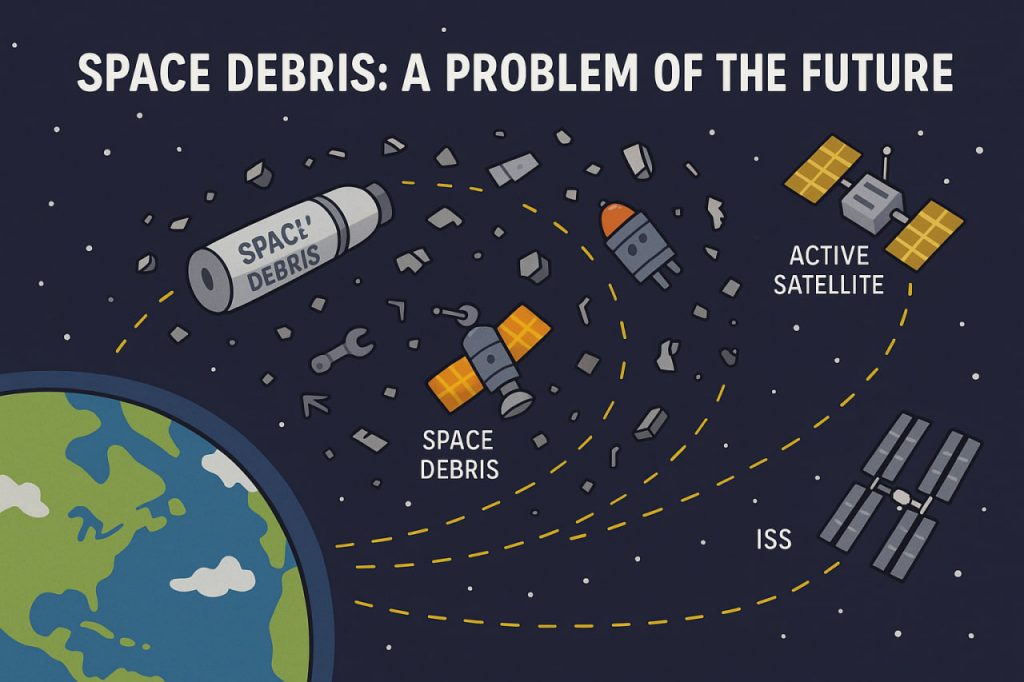Space debris, also known as space junk, refers to non-functional human-made objects orbiting Earth. These include defunct satellites, spent rocket stages, fragments from past collisions, and even tools lost during spacewalks. While most of this debris is small, even tiny objects can cause serious damage due to their high orbital speeds. As we launch more satellites and spacecraft, space debris has become one of the most pressing environmental challenges in near-Earth space.
Physical Risks and Dangers
Collision Hazards
Space debris travels at speeds of up to 28,000 km/h. At such velocities, even a piece the size of a paint chip can pierce spacecraft hulls or disable satellites. Large fragments can cause catastrophic damage during collisions.
Threat to Astronauts
Debris poses a serious risk to crewed missions. The International Space Station (ISS) regularly adjusts its orbit to avoid tracked objects, and its outer shell is reinforced to resist small impacts.
Satellite Disruptions
Active satellites that provide communication, navigation, and weather services are vulnerable to collisions, which could disrupt essential systems on Earth.
Causes and Growth of Space Junk
Satellite Proliferation
The number of satellites in orbit has increased dramatically, especially with the rise of mega-constellations like Starlink. Many older satellites remain in orbit long after they stop functioning.
Explosions and Collisions
Fuel residues in rocket stages can cause explosions, and past collisions between satellites (such as the 2009 Iridium-Cosmos incident) have created thousands of additional fragments.
Anti-Satellite Weapons
Tests by some countries using missiles to destroy satellites have created dangerous clouds of debris.
Possible Consequences for the Future
The Kessler Syndrome
If the amount of space debris increases unchecked, it could lead to a cascade of collisions that creates even more debris, potentially making some orbits unusable for decades. This scenario is known as the Kessler Syndrome.
Limited Access to Space
Too much debris could hinder new satellite launches, endanger astronauts, and delay space exploration.
Increased Costs and Complexity
Future missions will require enhanced shielding, more fuel for evasive maneuvers, and careful timing to avoid high-risk orbital regions.
What Can Be Done to Solve It?
Improve Satellite Design
Newer satellites are being designed to deorbit after their missions using onboard propulsion or drag-enhancing structures.
Debris Removal Technologies
Agencies and startups are developing methods like nets, harpoons, robotic arms, and even laser-based systems to remove large debris from orbit.
International Regulations
Agreements on responsible space operations, satellite disposal, and avoidance protocols are crucial. Organizations like the UN’s COPUOS and national space agencies are working toward global standards.
Better Tracking Systems
Ground-based radar and telescopes help monitor debris and warn of potential collisions, allowing satellites to maneuver in time.
Glossary
- Space debris – Non-functioning human-made objects orbiting Earth
- Kessler Syndrome – A chain reaction of space collisions that exponentially increases debris
- Orbital velocity – The high speed at which objects move to stay in Earth’s orbit
- Mega-constellation – A network of hundreds or thousands of satellites working together
- Deorbit – The process of bringing a satellite down to burn up in Earth’s atmosphere


